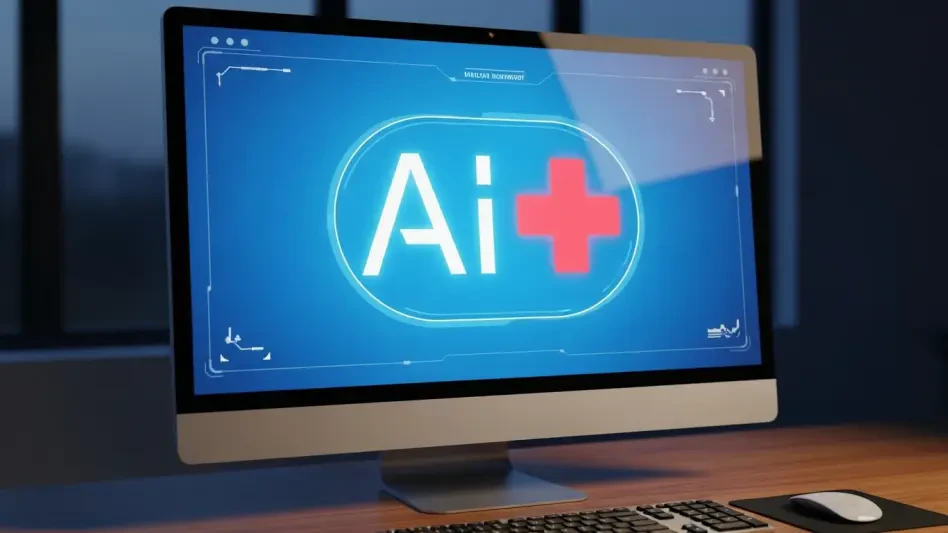Overview of AI’s Impact on Healthcare and Investment
The healthcare industry stands at a pivotal moment where artificial intelligence (AI), particularly large language models like ChatGPT, is driving a seismic shift in both clinical practices and financial landscapes. With tools capable of analyzing complex medical data at unprecedented speeds, AI is not only enhancing patient care but also opening lucrative avenues for investment. This transformative technology is being integrated into diagnostics, administrative workflows, and drug discovery, promising to redefine how healthcare operates while attracting significant capital from forward-thinking investors.
A closer look reveals that AI’s integration in healthcare is already yielding tangible benefits across multiple domains. Diagnostics powered by models like GPT-4 and GPT-4o are achieving near-human accuracy in interpreting medical imaging, while ambient scribing tools are slashing documentation time for physicians. Meanwhile, drug discovery is being accelerated by companies leveraging AI to cut research costs and timelines. Major players, including startups like Abridge and Ambience, alongside established entities, are at the forefront, with investors keenly eyeing the potential for high returns in this rapidly evolving sector.
The significance of these advancements extends beyond technology, directly impacting patient outcomes and fueling economic growth. Improved diagnostic precision and streamlined operations translate to faster, more accessible care, while the burgeoning AI healthcare market—spurred by both innovation and investment—contributes to job creation and industry expansion. This sets the stage for a deeper exploration of how AI is reshaping healthcare and why it has become a focal point for capital markets.
Technological Advancements and Market Growth in Healthcare AI
Key Trends and Innovations
AI adoption in healthcare is being propelled by cutting-edge trends, with large language models such as GPT-4 and GPT-4o leading the charge. These tools are not just enhancing diagnostics through high-accuracy analysis of medical imaging but are also transforming administrative tasks via ambient scribing, which automates clinical documentation with remarkable efficiency. Additionally, personalized medical education powered by AI is empowering both providers and patients with tailored learning resources.
Beyond diagnostics and documentation, emerging capabilities are addressing long-standing inefficiencies in the sector. The demand for operational streamlining is driving innovations like AI integration with electronic health records (EHRs), ensuring seamless data flow across systems. Startups are carving out niches in payer operations, while consumer expectations for quicker, more responsive care are pushing the boundaries of what AI can achieve in real-time patient interactions.
Market drivers are further amplified by the agility of startups in addressing specific pain points. Companies like Xaira and Recursion are revolutionizing drug discovery by using AI to identify promising compounds faster than traditional methods. These developments signal vast opportunities for innovation, particularly in areas like automated billing and claims processing, where precision and speed can yield significant cost savings for healthcare organizations.
Market Data and Future Projections
Current market statistics paint a vibrant picture of AI’s economic footprint in healthcare, with spending driven by this technology reaching $1.4 billion this year. Generative AI accounts for a staggering 85% of this growth, underscoring its dominance in shaping industry advancements. Specific sectors like ambient scribing, where startups hold a 70% market share, and billing automation, valued at $450 million, highlight the concentrated impact of niche innovations.
Looking ahead, certain growth sectors are poised for exponential expansion over the next few years. The life sciences domain, particularly in drug discovery, is expected to see robust investment, while claims processing automation is projected to grow at a significant annual rate. Investor interest remains strong, with funding trends indicating a sustained focus on AI solutions that promise scalability and efficiency in healthcare delivery.
Projections for the coming years, from now through 2027, suggest that AI’s role will only deepen, with broader applications in personalized medicine and operational automation. Market analysts anticipate that the convergence of technological advancements and rising healthcare demands will continue to attract substantial capital, positioning AI as a cornerstone of future industry growth and a magnet for strategic investments.
Challenges in AI Adoption for Healthcare
The journey toward widespread AI integration in healthcare is not without formidable hurdles, spanning technological, ethical, and operational dimensions. One pressing issue is algorithmic bias, where certain tools have been found to prioritize care inequitably across demographics, potentially exacerbating existing disparities. This underscores a critical need for robust data transparency and fairness in AI development.
Further complicating adoption is the limited clinical validation of many AI tools, with recent analyses indicating that only 64% have been substantiated with real-world data. This gap raises concerns about reliability in high-stakes medical decisions, where inaccuracies could have severe consequences. Addressing this requires rigorous testing protocols and a commitment to continuous improvement in model accuracy and applicability.
Solutions are emerging, however, with calls for enhanced transparency in data demographics and the adoption of ethical frameworks like Multiscale Ethics to evaluate AI fairness across various levels. Equally important is the emphasis on human-AI collaboration, ensuring that clinical expertise remains central to decision-making processes. Such partnerships can mitigate risks, preserving trust in healthcare systems while harnessing AI’s potential.
Regulatory Landscape and Ethical Considerations
The regulatory environment surrounding AI in healthcare is evolving rapidly to keep pace with technological advancements, with bodies like the FDA and EU playing pivotal roles. Through initiatives such as the FDA’s Algorithmic Vigilance program, ongoing oversight of AI tools is prioritized to safeguard patient safety. Meanwhile, stricter data controls under regulations like GDPR aim to combat bias and protect sensitive information.
Compliance with these standards is reshaping industry practices, compelling both startups and larger companies to embed ethical considerations into their development cycles. The focus on safety and equity means that AI deployment must balance innovation with accountability, a challenge that requires meticulous attention to regulatory guidelines and proactive risk management.
Collaborative governance is increasingly seen as essential to navigating this complex landscape. By fostering dialogue among regulators, healthcare professionals, and developers, a framework that supports responsible innovation can be established. This collective approach ensures that AI advancements align with societal values, prioritizing patient well-being over unchecked technological expansion.
Future Directions for AI in Healthcare and Investment
Looking toward the horizon, AI’s trajectory in healthcare points to groundbreaking developments and potential disruptors that could redefine the sector. Emerging technologies, such as advanced predictive analytics for personalized medicine, are set to tailor treatments to individual patient profiles with unprecedented precision. These innovations promise to elevate care quality while driving further investment interest.
Shifts in consumer preferences are also shaping the future, with a growing demand for faster, AI-enhanced medical services. Global economic conditions will likely influence investment patterns, with regions prioritizing healthcare modernization likely to see increased capital inflows. This dynamic underscores the interplay between market needs and financial strategies in scaling AI solutions.
Growth areas such as drug discovery and operational automation are expected to expand significantly, offering fresh opportunities for stakeholders. As regulatory frameworks evolve alongside technological progress, the sustainability of AI-driven healthcare solutions will hinge on maintaining a delicate balance between innovation and oversight, ensuring long-term benefits for both patients and investors.
Conclusion and Strategic Recommendations
Reflecting on the insights gathered, it is evident that AI, spearheaded by tools like ChatGPT, has carved a transformative path in healthcare, revolutionizing diagnostics, operational efficiency, and research capabilities. The substantial market growth, evidenced by a $1.4 billion spend in the sector, underscores the immense investment potential, drawing attention to both startups and established players.
Moving forward, stakeholders are urged to adopt a patient-first approach, with investors encouraged to focus on ventures that prioritize equitable outcomes over short-term gains. Developers need to integrate ethical frameworks into AI design, ensuring fairness and transparency, while regulators are advised to sustain collaborative efforts to refine oversight mechanisms.
As a final consideration, the focus shifts to fostering innovation through strategic partnerships across the ecosystem. By aligning technological advancements with societal needs, the groundwork is laid for a more inclusive and effective healthcare system, provided that responsibility remains at the forefront of every initiative.









